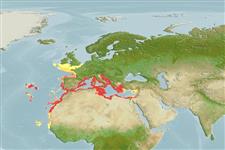Environment: milieu / climate zone / depth range / distribution range
Ökologie
seewasser riff-verbunden; tiefenbereich 1 - 801 m (Ref. 58348), usually 100 - 300 m (Ref. 58348). Subtropical; 52°N - 13°N, 32°W - 36°E
Eastern Atlantic: south of British Isles to Senegal, including the Mediterranean, Azores, Madeira, Canary Islands, and Cape Verde.
Length at first maturity / Size / Gewicht / Alter
Maturity: Lm 75.5, range 69 - ? cm
Max length : 150 cm TL Männchen/unbestimmt; (Ref. 12382); common length : 80.0 cm TL Männchen/unbestimmt; (Ref. 3397); max. veröff. Gewicht: 6.5 kg (Ref. 58348); max. veröff. Alter: 38 Jahre (Ref. 58348)
A nocturnal and territorial species (Ref. 12382), commonly lurking in holes, and writhing snakelike through crevices, under rocks or corals. Feeds on fish, crabs and squid (Ref. 12382). It seldom attacks unless provoked (Ref. 3256). A gonochoristic species (Ref. 32169). Utilized fresh and eaten broiled, boiled and baked; the skin can be used for leather (Ref. 9987).
Migrate to offshore waters to spawn (Ref. 98745).
Smith, D.G. and E.B. Böhlke, 1990. Muraenidae. p. 136-148. In J.C. Quero, J.C. Hureau, C. Karrer, A. Post and L. Saldanha (eds.) Check-list of the fishes of the eastern tropical Atlantic (CLOFETA). JNICT, Lisbon; SEI, Paris; and UNESCO, Paris. Vol. 1. (Ref. 4450)
IUCN Rote Liste Status (Ref. 130435)
Bedrohung für Menschen
Traumatogenic (Ref. 4690)
Nutzung durch Menschen
Fischereien: weniger kommerziell; Aquarium: Öffentliche Aquarien
Tools
Zusatzinformationen
Download XML
Internet Quellen
Estimates based on models
Preferred temperature (Ref.
123201): 13.1 - 16.2, mean 14.4 °C (based on 181 cells).
Phylogenetic diversity index (Ref.
82804): PD
50 = 0.5010 [Uniqueness, from 0.5 = low to 2.0 = high].
Bayesian length-weight: a=0.00056 (0.00048 - 0.00066), b=3.27 (3.23 - 3.31), in cm total length, based on LWR estimates for this species (Ref.
93245).
Trophic level (Ref.
69278): 4.2 ±0.61 se; based on food items.
Widerstandsfähigkeit (Ref.
120179): sehr niedrig, Verdopplung der Population dauert mehr als 14 Jahre. (tmax=38.1; tm=7.1; K=0.078).
Fishing Vulnerability (Ref.
59153): Very high vulnerability (79 of 100).
Climate Vulnerability (Ref.
125649): Moderate to high vulnerability (53 of 100).
Nutrients (Ref.
124155): Calcium = 11.6 [5.8, 23.4] mg/100g; Iron = 0.433 [0.231, 0.841] mg/100g; Protein = 19.3 [17.0, 21.8] %; Omega3 = 0.193 [0.077, 0.603] g/100g; Selenium = 40.8 [19.0, 84.1] μg/100g; VitaminA = 42.5 [12.0, 154.1] μg/100g; Zinc = 0.452 [0.295, 0.682] mg/100g (wet weight);
